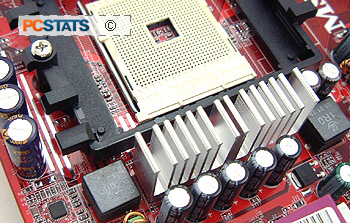One thing about nVIDIA that I really like is how the
company is not afraid to try new things. Dual-channel DDR, SLI... the list goes
on. It would be fair to say that much of the AMD Athlon64's success in the post-PCI Express world is due to nVIDIA and its awesome
nForce4 chipsets. Fast, price competitive and stable, the
nForce4 chipset boasts the kind of maturity that usually only Intel offers.
That's good news for AMD since its other chipset vendors have had a difficult time making waves.
Originally AMD and its partners were vague about the upgradability of
Socket 754 processor, since the platform was to be replaced quickly with Socket 939 and plans
for PCI Express support were sketchy. I'm happy to see that nVIDIA has not forgotten
about early adopters and its nForce4-4X chipset is exactly what the doctor
ordered.
Aside from Serial ATA II support (which really is not
important yet), the nForce4-4X has everything an upgrader would want. The PCI
Express architecture has been pegged to have a lifespan of around ten years,
so with a nForce4-4X motherboard, Socket 754 Athlon64 users can breath new
life into their systems.
Today, PCSTATS will be looking at MSI's
nForce4-4X entry, the K8N Neo3-F. This motherboard supports all AMD Athlon64 and
Sempron Socket 754 processors and up to 2GB of single-channel DDR memory. As
with other nForce 4 chipsets, PCI-Express is integrated and the K8N Neo3-F
sports a full PCIe x16 slot for video cards as well as a single x1 slot for
peripherals. A standard compliment of four SATA 150 ports and two IDE
controllers are present, as well as four built in USB 2.0 ports and two more on
the included PCI bracket.
The MSI K8N Neo3-F motherboard looks like an ideal
board for upgraders since it also features a physical 8x AGP
slot using what MSI term the "AGR" (Advanced Graphics Riser)
technology; more on this later. Other features of the motherboard include a
Gigabit NIC and a 5.1 channel audio codec, but perhaps the best 'feature' is its
price, just $98CDN ($78US).
As you can see, the MSI K8N Neo3-F uses a smaller 7.5" by 11.5" six
mounting-hole ATX-sized PCB and will fit just fine in pretty much any case.  The
board is small, but MSI still does a decent job with motherboard layout.
The
board is small, but MSI still does a decent job with motherboard layout.
One thing I really liked was how MSI colour coordinates and labels the
positive power pins on its USB headers! Anyone who has installed front panel USB
headers knows how much of a pain it is to always have to refer to the manual. I
know I've done it about four times in the last two weeks...
The K8N Neo3-F natively support ATX 2.0 standard power supplies but
don't worry, the board is also compatible with older versions. If you're already
an Athlon64 user looking to upgrade, the power supply you're currently using
should be fine.
MOSFETs generate a lot of heat, and to help keep the ones
on the K8N Neo3-F cool, MSI placed aluminum heatsinks on them. During testing
they worked quite well, getting warm to the touch.

The nForce4-4X chip is placed in an easy-to-access spot
on the K8N Neo3-F board, so if you wish you could easily replace the stock
cooler with whatever you like. The default HSF is quiet and does the job nicely,
so I can't see many users swapping it out for something better.

The only thing about the motherboard I disliked was the
little PCI Express videocard locking mechanism. It has to be the hardest thing
in the world to access and really does require a tool to remove the videocard
properly. I found it easier to take the videocard out of its slot from the front
first. The K8N Neo3-F is an
entry-level motherboard but I would have liked to see MSI include a few more cables.
Including one Serial ATA cable seems a bit cheap on MSI's part. We did appreciate
the inclusion of an extra USB 2.0 bracket though.

